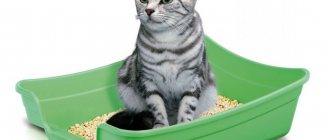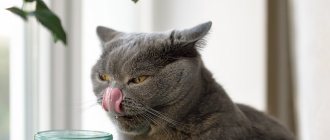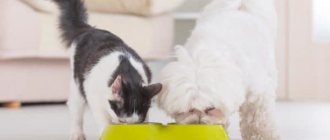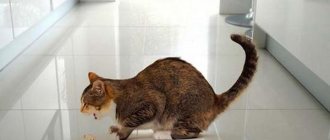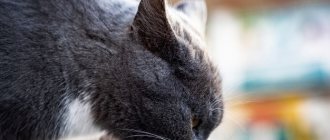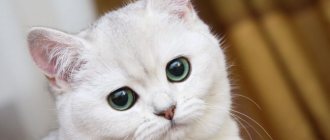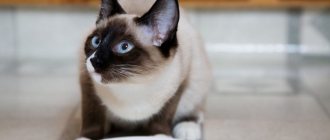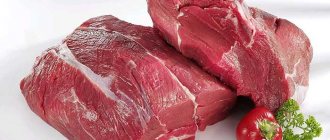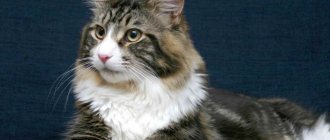Feeding plays a decisive role in maintaining the appearance and fitness of furry pets. Despite their inherent sense of proportion in food, their diet should be taken under control. Due to the fact that prolonged lack of interest in food leads to serious consequences, you need to monitor the amount of food consumed. How to feed a cat if it refuses to eat, and what appetite stimulants exist, read on.
How to feed a cat if he refuses to eat
Need for food
The optimal daily dose is calculated based on body weight, age and some breed characteristics.
Cats are not naturally prone to obesity.
General feeding rules:
- For an adult animal, the norm is 40 g of natural food per 1 kg of body weight.
- The total amount of food should not exceed 250 g per day.
- For inactive, aged, obese and neutered cats, the portion size is reduced by 20%.
- When preparing a diet, you need to take into account the fact that cats eat more cats. The daily energy requirement of a male is 80 kcal/kg, and that of a female is 60 kcal/kg.
- Since super-premium and holistic food has a high energy value, the daily dose should be no more than 20 g of food per 1 kg of weight.
- If the diet is based on several varieties of industrial feed, the proportion of dry should be 75% and wet - 25%.
- Daily feeding rate for a kitten:
- 8 weeks - up to 150 g, number of feedings - 6;
- from 3 to 6 months - up to 240 g with 4 meals a day;
- from 6 to 9 months - up to 250 g, number of feedings - 3;
- from 9 to 12 months - up to 200 g with 2 meals a day.
After 1 year, the baby is transferred to an adult feeding regimen.
It is important to maintain a balance between wet and dry food
The daily requirement of an adult animal for protein of animal origin is 6 g per 1 kg of body weight, for a kitten - 10 g per 1 kg. Carbohydrates, regardless of age, are required in the amount of 3 g/kg, and fats - 2.25 g/kg.
What to do if your cat only eats dry food
Veterinarians have differing opinions about the quality of dry food. Most of them claim that only a cheap product is of low quality. Extra-class food is balanced and its price corresponds to the quality. The food is complete in terms of the presence of nutritional components.
It’s a completely different matter when an animal’s health problems begin. And the veterinarian insists on changing the type of food, citing an artificial surrogate as the reason for everything. In this case, you need to minimize the intake of such food so as not to harm the animal even more.
Reasons for losing interest in food
A healthy appetite is considered one of the signs of good health. Loss of this physiological mechanism can be the first symptom of numerous diseases. To prevent the development of dangerous pathologies, it is necessary to identify the reason for the animal’s refusal to eat.
Appetite problems most often occur in kittens under 6 months of age.
Any form of anorexia
Loss of appetite can be not only one of the clinical manifestations of the disease, but also an underlying problem. Anorexia develops gradually. At the first stage, there is a slight decrease in nutritional needs. Late stages are characterized by complete refusal to eat.
When all body systems are functioning normally, the cat eats with pleasure.
Constant stress
Furry animals are big conservatives who do not welcome change. Disruption of the usual way of life causes discomfort. A cat may lose its appetite in the following situations:
- rearrangement of furniture;
- too bright lighting;
- repair;
- lack of attention from the owners;
- loud noise;
- the appearance of a new pet;
- busy indoor traffic;
- moving;
- quarrel between family members;
- too strong negative or positive emotions;
- changing the location of the food bowl.
In addition, stress can be a symptom of exacerbation of a chronic disease.
Cats are classified as touchy pets.
Sexual instinct
With the onset of the mating period, animals often forget to eat, completely concentrating on natural instincts. This is especially true for pets living next door. The female sometimes refuses food for 1 week or during estrus.
Availability of an alternative food source
If the cat often walks, he can get food on the street. Animals leading a yard lifestyle feed on rodents and small birds. Upon arrival home, the pet is limited to liquid absorption.
Cats that get their own food do not need additional feeding
Present diseases
Loss of appetite as a symptom relates to many diseases. Among the most typical are the following:
- Infections of viral and bacterial origin, accompanied by a runny nose. Due to the partial loss of smell, the animal loses interest in food. The most common pathologies are panleukopenia, calcivirosis, rhinotracheitis and peritonitis.
- Brain damage. Any traumatic brain injury or stroke affects the ability to perceive smells, which automatically affects appetite.
- Diseases of the digestive system. Most diseases of the pancreas, esophagus, liver, stomach and intestines lead to food refusal.
- Pathologies of the oral cavity. Dental problems also affect appetite. If a cat has a toothache, it will not be able to eat food even if it has a good appetite. Periodontal disease, the presence of a foreign object in the mouth, tartar or jaw injuries can lead to depletion of the pet.
Some diseases of the eyes, kidneys, skin and blood also contribute to poor appetite
Fasting day
Cats, like people, periodically cleanse their bodies. To cleanse the intestines, they limit themselves exclusively to the absorption of liquid during the day. Photo 6. Pregnant and lactating females sometimes forget about the need to eat.
Pregnancy and postpartum period
The maternal instinct of expectant and nursing mothers forces them to put the needs of their babies first, ignoring their own needs. In addition, physiological features also affect appetite. Refusal to eat occurs in the following situations:
- toxicosis;
- postpartum stress;
- eating more than one placenta after childbirth;
- reluctance to leave babies unattended for food.
In addition, the body needs time to recover after childbirth. As a rule, the animal does not eat during this period.
Sometimes, while recovering from childbirth, a cat will refuse to eat.
Increased weather sensitivity
Cats are very sensitive to changing weather conditions. Strong wind, lack of sun, cloudy weather negatively affect the emotional state and lead to loss of appetite.
Taking medications
A side effect of taking some medications is a lack of interest in food. This is especially true for drugs used during chemotherapy and non-steroidal anti-inflammatory drugs.
Refusal to eat is a side effect of taking medications
Consequences of anesthesia
Agents used for anesthesia slow down many physiological processes in the body, including eliminating the need for food. For several days after surgery, the animal may not show interest in food.
Neurological disorders
When a cat becomes apathetic, it loses interest in itself and what is happening around it. In addition to the fact that the animal stops playing and observing the rules of personal hygiene, it loses its appetite.
Cats tend to get depressed
Allergic reactions
Food allergies are a fairly common occurrence among furry pets. In the absence of timely treatment, cats’ sense of smell decreases and, as a result, they lose interest in food.
Food allergies in cats
Nutritional Features
The filling of the diet and feeding regime are interconnected with the emergence of the need for food. A cat loses its appetite in the following situations:
- sudden change of food.
- excessive overeating.
- use of low-quality products.
- frequent feeding of difficult-to-digest foods.
After food poisoning, the animal may refuse to eat.
If your pet ignores food for more than 24 hours in a row, it is necessary to take it to the veterinarian and begin force feeding.
Even daily fasting is fraught with the development of fatty liver
Reasons for refusing dry food
Sometimes refusal to eat is associated with the animal’s reluctance to eat industrial products. However, the cat can be completely healthy and have a good appetite.
Ignoring pelleted feed occurs in the following situations:
- The composition is not suitable.
- The expiration date has expired.
- The product has absorbed foreign odors and moisture.
- Bored of monotonous food.
- Feeding stale food that has lost its flavor.
- Dirty dishes.
- Lack of drinking water.
- Transition from natural to industrial food.
Different mechanisms underlie dry food refusal and loss of appetite
In addition, the age factor is relevant. This type of food is not suitable for kittens and elderly animals due to difficulties during chewing.
What to feed a sick cat
Unfortunately, some owners treat their pets lightly, believing that purebred cats do not get sick, and if the pet gets sick, it will recover. This approach is very dangerous! Cats need prevention of viral diseases and parasitic infestations. An animal deprived of care is guaranteed to get sick or even die, it’s a matter of time.
What happens to a cat's body during illness? In fact, the symptoms that the owner sees are only a small part of the changes to which the body has to adapt. No matter what the cat is sick with, its immunity comes into tension, that is, leukocytes constantly multiply in the blood. The only exception is immunodeficiency, in which white blood cells die.
Constant cell division and the fight against disease requires enormous resources, so proper feeding of the cat during the period of illness plays a key role. Naturally, the cat’s recovery will depend on the efficiency and competence of treatment, comfort and care that the owner can provide.
Properly feeding a sick cat means being as aware of its needs as possible.
Yes, here we are talking specifically about guessing and intuitive decisions. If you have the opportunity to regularly have your pet’s blood tested, that’s great, but if you don’t have the opportunity, you will have to act according to the situation. The diet of any animal should be rich in protein, vitamins, minerals, amino acids and fats. If a cat has lost weight or is exhausted, its diet is supplemented with carbohydrates, but one must not overdo it.
The diet of a sick cat should be selected taking into account the following factors:
- At high temperatures, friendly bacteria of the intestinal microflora die, that is, dysbiosis develops. In such a situation, the cat will only benefit from quickly and easily digestible foods.
- A sick animal has irritated mucous membranes, including the oral cavity and intestines. To facilitate the process of absorption and assimilation of food, it is better to grind the treats to the consistency of a pate.
- The calorie intake should strictly depend on the cat's needs. If the animal is exhausted, the veterinarian will prescribe nutritious food, such as those produced by some manufacturers of industrial animal feeding. If the pet is overweight, a diet is prescribed to reduce the percentage of fat mass, but taking into account the maintenance of vitality.
After surgical interventions, especially if the operation was difficult and resulted in several stitches, a light diet is prescribed. The point is that the cat should drink a lot and eat only dietary foods. This way, the cat will go to the toilet, mostly in small quantities, and will not strain its muscles to empty its bowels. If the operation was performed on the abdominal cavity, a light diet is prescribed until the sutures are removed. The exception is sterilization and castration. With modern methods, the cat can be returned to its usual diet within a day after surgery.
Most veterinarians recommend switching a sick animal to special industrial feed . Many people know that there are specially medicated foods designed for animals with:
- Allergies.
- Urolithiasis.
- Sensitive digestive system.
- Ailments of the musculoskeletal system and others.
As you can see, medicinal food is intended for animals with chronic pathologies.
Note! Some manufacturers produce food designed to rehabilitate cats in stressful situations. Such products are also considered medicinal and should be used as prescribed by a doctor.
There are also specialized foods for cats in critical condition, although their choice is much smaller. Typically, such products contain a lot of protein (70–85%) and a powerful vitamin complex. Rehabilitation feeds are available in liquid form (in tubes) or ground into a pate . In the first case, the food is used for force feeding; the pate is intended for cats that have an appetite and try to eat on their own.
Rehabilitation food is very tasty and aromatic, which encourages even a very weak cat to eat. If you are not sure whether your pet will eat, it is better to purchase food in a tube, since a weakened pet will be more likely to lap than chew.
Is it possible to feed a cat natural food during rehabilitation? In principle, it is possible, besides, about 5 years ago there were no feeds for rehabilitation and pets were nursed on natural food. To simplify the digestion process, the diet should include boiled meat, ground to a smooth paste, cottage cheese and fermented milk products. Meat pate can be diluted with broth to be drawn into a syringe or offered to the cat to lap from a saucer.
Reasons for refusing water
Despite the fact that the life of warm-blooded animals is impossible without water, furry pets consume liquid in limited quantities.
Cats are light drinkers
Table 2. Reasons why a cat neglects water
| Provoking factor | Description |
| Wet food | Spiders reduce the need to drink. |
| Mouse Hunt | If a cat eats caught mice, the need for drinking water is significantly reduced. |
| Replacing water with other sources of fluid | Frequent consumption of milk and broth can discourage your cat from drinking water. |
| Development of diseases | One of the most dangerous diseases leading to hydrophobia is rabies. In addition, the feeling of thirst is affected by urolithiasis, decreased protective functions of the body, internal damage, and pathological conditions of the oral cavity. |
| Season | In late autumn and winter, the animal's need to absorb fluid decreases. |
| Dirty dishes | Since furry pets love cleanliness, they do not drink from unwashed containers. |
Loss of appetite in cats is more common than refusal of water.
Milk and other liquids do not replace water
Mr. Cat recommends: problem solving
In order to restore your pet’s appetite, you first need to figure out whether physiological or pathological causes lie at the root of the problem and only then solve it.
To prevent loss of appetite, it is necessary to provide your pet with a high-quality and nutritious diet.
If a cat’s complete or partial refusal to eat is not associated with illness, then there are several ways to return to normal appetite:
- Diversify your diet with fresh meat and poultry.
- If you have sensitive digestion, choose special foods.
- Avoid eating spicy and fatty foods, pickled and salty foods, and sweets.
- Sometimes raw chicken yolk helps as a stimulant. You should not give it to your cat more than once a week.
- Fish, grains and greens in limited quantities can also relieve digestive problems.
- Catnip is a good appetite stimulant.
Read the article about natural cat nutrition.
In order to identify exactly what problems led to the cat’s loss of appetite, you should proceed according to the following scheme:
- Try to interest your pet in a new tasty dish.
- Observe the animal for a few days, maybe it’s just a natural hunger strike. It should be remembered that it is harmful for a kitten not to eat for more than a day.
- If an adult cat’s appetite does not return within five days, you should contact a veterinary clinic and follow all doctor’s instructions.
- If vitamin complexes are prescribed, you should purchase them at a veterinary pharmacy. Now there are many preparations containing seaweed, catnip, yeast, and other micro- and macroelements. They are developed and produced specifically for cats and act, as a rule, by improving metabolism. Sometimes special sprouted grass helps.
- It may help to switch your pet to high-quality holistic or super premium dry food. Among the best brands are Acana, Orijen, Applaws, GO!.
How to make a cat drink
So that your furry pet does not forget about the need to absorb liquid, you can resort to small tricks:
- Buy an artificial fountain that no curious cat will pass by.
- Turn on the tap in the presence of an animal.
- In emergency cases, inject water using a syringe.
Experienced cat owners do not recommend placing a container of water in close proximity to the food bowl.
In the wild, cats do not drink water near killed game. In some domesticated pets, the genetic code is triggered, which forces them to neglect the water standing next to their food.
An artificial fountain is an effective means of stimulating the feeling of thirst.
Causes of decreased appetite in cats
If a beloved domestic cat suddenly stops eating well or refuses to eat at all, this immediately alerts the owners. The reasons that a pet does not eat food can be different. The most common reason is that the cat is overfed and his body requires unloading. This is the most harmless reason, which usually does not bring with it any bad consequences. But most often, cats eat poorly due to weakness and malaise, a clogged nose (the animal cannot smell the food), and also due to stress. Stress can be caused by a sudden rearrangement of furniture, moving, or lack of attention to the animal.
A caring owner will immediately discover that something is wrong with the cat if he has not touched food for a whole day. When a cat does not eat for more than two days, this is an indicator of a serious illness that needs to be treated. The most unpleasant thing is when a pet refuses food and water completely. He may lose serious weight and become very weak. This cannot simply be left alone, which is why veterinary practice often resorts to force-feeding animals.
Force feeding rules
This method of feeding is especially relevant for animals suffering from anorexia. Kittens and sick pets also often need help from their owners.
Basic methods of force feeding:
- Enteral. Nutrients are introduced into the animal's body through a tube placed in the stomach or rectum.
- Parenteral. Useful elements are administered intravenously.
- Tools at hand. Animals are fed using a syringe or bottle.
A bottle is often used to feed kittens
Depending on the physical condition of the cat, the appropriate feeding method is selected. To feed a pet, in addition to the methods listed, owners lubricate the animals’ lips with liquid food or gently push the food into the esophagus.
Features of syringe feeding
Before you begin introducing food into your cat’s body using this medical instrument, you should familiarize yourself with the nuances of its use. Otherwise, you can injure your pet's oral cavity.
Using a syringe is effective when feeding adult cats
Basic Rules:
- Prepare for use. It is recommended to buy a 2 ml syringe. Before placing it in the pet's mouth, the nose of the syringe should be trimmed with scissors and the inlet opening should be enlarged to the size of the needle protective cap. Then cut off its tip and insert it into the flask.
- Pour liquid food or pate into the tool.
- Place your pet on your lap.
- Bring the syringe to the animal's nose. This will cause the cat to react to the smell of food and open its mouth.
- If your pet clenches its jaws tightly, you need to gently unclench your teeth. A small gap will be enough.
- It is advisable to slightly raise the cat's face.
- The instrument should not be inserted into the larynx, but behind the cheek.
- Give food while exhaling.
- Using gentle pressure on the piston, pour small portions of food into the oral cavity.
- It is necessary to ensure that the animal has time to swallow food.
- It is important to prevent liquid from entering the windpipe.
If your pet is choking, feeding must be stopped.
If loss of appetite is caused by an emotional state, you need to lubricate your lips with the animal's favorite food
Force feeding an adult cat
Since forceful feeding causes stress in cats, more humane methods should be started.
Place a small piece of food on the root of the tongue and gently close the cat's mouth. Then, using stroking movements, move from top to bottom along the throat several times. This will stimulate the swallowing reflex.
Photo 16. B vitamins enhance the sense of smell.
In order for the animal to develop an appetite, it is necessary to use food stimulants.
Table 3. Nutritional stimulants
| Provoking factor | Description |
| Wet food | Spiders reduce the need to drink. |
| Mouse Hunt | If a cat eats caught mice, the need for drinking water is significantly reduced. |
| Replacing water with other sources of fluid | Frequent consumption of milk and broth can discourage your cat from drinking water. |
| Development of diseases | One of the most dangerous diseases leading to hydrophobia is rabies. In addition, the feeling of thirst is affected by urolithiasis, decreased protective functions of the body, internal damage, and pathological conditions of the oral cavity. |
| Season | In late autumn and winter, the animal's need to absorb fluid decreases. |
| Dirty dishes | Since furry pets love cleanliness, they do not drink from unwashed containers. |
In addition, veterinarian nutritionists recommend giving animals heated food. Heating enhances the smell of food and attracts the cat's attention. Heated food activates your pet's natural instincts.
Cats are predators that feed on warm, freshly killed prey in their natural habitat.
When using medications as appetite stimulants, you should consider possible side effects:
- increased heart rate and breathing;
- dry mouth;
- prolonged constipation;
- increased body temperature;
- drowsiness or overexcitation;
- decreased urination;
- frequent meowing.
Medicines should not be used unless recommended by a veterinarian
The dosage of drugs must be agreed with your doctor.
Video - Force feeding a cat
Force feeding a sick cat
If the pathology present is not fatal, such as parvovirus enteritis, for which enteral nutrition is prescribed, industrial feeds can be used. They stimulate appetite and have a healing effect on the pet’s body.
Medicinal feeds are produced mainly in liquid form. The choice of this consistency is dictated by the need for force-feeding using a syringe. If the cat feeds on its own, the porridge-like consistency promotes better absorption of food.
Feeding rules:
- Give medicinal feeds in doses, since they have a high calorie content.
- If within 15 minutes the pet has not eaten the food offered, it should be thrown away.
- I heat the food to the cat’s body temperature - 38.5 degrees.
To stimulate appetite, you can place a small amount of food on the animal's lips.
With poor appetite, food designed for sick animals helps
Steps
Feeding a sick kitten
- Offer your kitten food in small portions often.
When your kitten gets sick, it is best to feed him small meals more often. Therefore, it is ideal to give your kitten a little food every hour or two, just don't wake him up to feed him.
Change the brand of your kitten's food.
Sometimes sick kittens don't want to eat regular food and need to be given something different to get them interested in food. Changing the brand or flavor of food may be able to pique your kitten's interest enough to get him to try some of the new food. When a kitten is sick, even a small amount of food he eats makes a huge difference. The following is a list of foods that are easy for sick kittens to eat:
Consult your veterinarian about a healthy diet.
A convalescent diet is specifically designed to meet the needs of sick animals that are not eating well. It is extremely nutritious, so a one-kilogram kitten can get its daily calorie intake by eating only a third of its usual amount of food. The best known health food brands are two brands: Hills AD (suitable for cats and dogs) and Royal Canin Feline Convalescent Diet. These highly appetizing foods include:
- proteins, which are the building blocks for the repair of body tissues and strengthen the immune system;
- fats and carbohydrates, which provide energy for metabolism so that the kitten’s internal organs can function normally and fight infection;
- zinc and potassium, which promote wound healing;
- Vitamins E and C, as well as taurine, which have antioxidant properties, remove toxins from the body and further strengthen the immune system.
- Try heating the food.
If your kitten has a stuffy nose, he'll stop eating for two reasons: he won't be able to smell the food, and he'll have difficulty eating with a stuffy nose. Try warming the food slightly (no more than 30 seconds in the microwave) and then giving it to the kitten. Warming it up will enhance the smell of the food and will very likely make the kitten eat at least a little. Plus, reheated food tastes better.
- Clearing your kitten's nose with nasal drops can also encourage him to eat better.
A sick kitten needs medication, but you should never make the mistake of mixing medication into the food. The kitten will sense the medicine, both by smell and taste, and will refuse to eat food with the medicine. Your attempt to mix medicine into the food will only lead to the fact that the next time the kitten simply does not want to go to his bowl, regardless of whether there is medicine in the food or not.
- Separately, force-feed the medicine to the kitten at regular intervals. This will be an unpleasant task and the kitten will not like the procedure, but it is necessary.
It is very important to make sure your kitten is drinking enough water and staying hydrated. Dehydration can be a very serious problem for kittens, and the problem becomes even worse if they become ill. If your kitten refuses to drink water, try adding some water to his food. This will not only make the food thinner, but will also replenish the animal's water balance.
- The first thing you should do when your kitten starts refusing water is to check the cleanliness of his water bowl. Kittens do not like to drink water from dirty dishes.
Take some food on your finger and bring it to the kitten's mouth. Try not to put your finger in your kitten's mouth, as he won't like it. Let the kitten lick your finger food on its own and be patient.
Try feeding your kitten with a syringe.
If the kitten refuses to eat from your finger, resort to syringe feeding. You will need a clean syringe without a needle filled with liquid food. Carefully pick up the kitten and insert the syringe into its mouth at an angle. Do not insert the syringe directly, as this will force food directly into the kitten's throat, which can cause choking. Turn the syringe left or right and squeeze some food onto the base of your kitten's tongue. The kitten will have to swallow the food that ends up on the root of its tongue. Repeat the procedure several times until you decide that the kitten has eaten enough, while periodically changing the position of the syringe so as not to irritate the kitten's mouth too much in the same place.
- Try using a liquid cat milk replacer unless your veterinarian prescribes another type of liquid food. Do not use regular cow's milk.
The food should be at room temperature or slightly warm, but not hot.
Caring for a sick kitten
- Give the kitten meloxicam.
Meloxicam (also known as metacam) is a non-steroidal anti-inflammatory drug. Meloxicam blocks the COX-2 enzyme that causes the production of prostaglandin, resulting in a reduction in fever-causing inflammation. Meloxicam is a safe and useful medicine for reducing high fever
- The recommended maintenance dose of feline meloxicam is 0.05 mg/kg per day. That is, a kitten weighing 1 kg needs 0.1 ml of Metacam for cats. Please note that meloxicam is available in two different dosages: for dogs (1.5 mg/ml) and for cats (0.5 mg/ml). Metacam for dogs is 3 times more concentrated, so when using it on cats you need to be very careful, as an overdose can easily occur.
Meloxicam can only be used in animals with normal fluid balance. Dehydrated animals may have weakened kidney function, and the additional reduction in blood supply to the kidneys can lead to kidney failure.
- Meloxicam can only be given after or during meals. If the kitten is not eating, be sure to fill its stomach with at least a small amount of food by syringe feeding it. Do not give Metac on an empty stomach. Otherwise, the effect of restricting the blood supply to the stomach will be excessively enhanced, which may lead to serious stomach ulcers.
- Do not give meloxicam with or after the use of other non-steroidal anti-inflammatory drugs or steroids. This can cause stomach and intestinal ulcers and bleeding, potentially leading to fatal blood loss.
- Keep your kitten warm.
A cold kitten will be lethargic and its recovery will be slower, all of which will complicate your task of feeding the kitten.
Provide the kitten with a comfortable nest.
Sick kittens feel vulnerable and recover better if they have a place to hide. Prepare a nest for the kitten from a cardboard box lined with blankets.
Seek veterinary help if necessary.
If your kitten seems very sick or its symptoms last longer than one day, contact your veterinarian.
Helping a depressed kitten
- Look for signs of depression in your kitten.
In addition to refusal to eat, depression can be indicated by a number of other symptoms. These include lack of energy and sleeping longer than usual, loss of interest in normal activities, being unsociable or exhibiting aggressive behavior.
Spend more time with your kitten.
The most common cause of depression in kittens is that they are not getting enough attention. To combat feline depression and get your kitten to eat normally again, play with him and show him love as much as you can. Hold your kitten in your arms while you work or watch TV, play with it in the mornings and afternoons, and pamper it with treats and attention.
Find something to keep your kitten entertained.
You won't always be able to be home to play with your kitten. Buy him some toys that will allow him to have fun when you are not around. To entertain your kitten in your absence, special climbing frames, puzzle toys with treats placed inside, and other types of cat toys are perfect.
- Consider getting your kitten a friend. If you can afford it, bring home another kitten so they can play with each other. However, you should remember that the procedure for adding a new kitten can be more difficult the older your first kitten is.
If you give your kitten enough attention and show him love on a regular basis, this is probably not what upsets him at all. Perhaps he is depressed because he is experiencing some pain, either due to illness or injury. If you cannot determine on your own what exactly is bothering your kitten, take him to the vet.
Using veterinarian-prescribed appetite stimulants
- Use appetite stimulants as a last resort.
There are medications that have a stimulating effect on appetite. They should only be used in kittens as a last resort, and this is due to a number of reasons. First, many of these medications are human medications, making breaking and crushing tablets to obtain the small dose needed extremely difficult. Secondly, young kittens have not yet fully developed liver and kidney functions. These organs are not yet fully functioning and therefore cannot break down medications as efficiently as possible, potentially making a kitten more likely to overdose than an adult cat. Finally, these medications have unpleasant side effects even when used in minimal doses.
Consult your veterinarian for advice.
An experienced veterinarian will be able to decide what medication to prescribe for your kitten, if it really needs it. The most common types of medications are listed below, so you can ask your veterinarian about them, who will explain them to you and tell you the appropriate dosage.
Consider using mirtazapine.
This is a human medicine from the group of tricyclic antidepressants. Although there is no evidence as to why this occurs, this medication appears to have a stimulating effect on cats' appetite. The tablets produced have a minimum dosage of 15 mg, and the adult cat dose is 3.5 mg, which is approximately equal to a quarter of the tablet. For small kittens weighing less than a kilogram it is extremely difficult to calculate the appropriate dose, you will only need to give your pet a small crumb of the tablet. This medicine can only be given once every three days.
Consider cyproheptadine.
This is another type of human medicine. It is an antihistamine and a serotonin receptor blocker. Again, it is not known why this medication increases appetite in cats. A dose of 0.1-0.5 mg/kg is given by mouth two to three times daily. The minimum tablet size is 4 mg, so it is extremely difficult to accurately split the tablet into small enough pieces (as is the case with mirtazapine). For example, a kitten weighing 1 kg requires one eighth of this tablet, and kittens reach this weight only by the time they are three months old.
Be careful with steroid injections.
A side effect of steroid use is an increase in appetite. In most cases, they are not used on sick kittens because steroids also suppress the immune system, which can weaken the kitten's ability to fight infection. However, if the kitten is protected by antibiotics and the veterinarian has determined that steroids will not worsen his current condition, a one-time use of a steroid to increase appetite may be acceptable. The dosage of the drug can vary greatly and ranges from 0.01 to 4 mg/kg dexamethasone, but it is recommended to conservatively adhere to the minimum dosage when using the drug to increase appetite. Therefore, a kitten weighing 1 kg requires 0.5 mg of dexamethasone, which, when using a solution with a concentration of 2 mg/ml, is 0.25 ml per intramuscular injection.
- Play a variety of soothing music for your kitten. If you notice that your kitten responds to a certain type of music, leave that music on when you leave the house. This will calm your pet and prevent him from becoming depressed.
What kind of water does a cat need?
Before getting a pet, you need to remember that you will have to feed and water it only with the highest quality products. This can be natural food or food from a good manufacturer. Regardless of the choice of food for a cat, every owner must provide the animal with clean and fresh drinking water. Veterinarians do not recommend giving your cat tap water. They claim that it will be healthier for the animal to drink spring or filtered water, since tap water contains a large amount of chlorine, metal salts and dirt. Boiled water does not have any beneficial substances.
Veterinarian advice
Veterinarians advise carefully monitoring your domestic cat's daily drinking habits. This will allow you to notice a lack of water in the early symptoms of dehydration and even prevent the development of urolithiasis. Those who feed their pet dry food should be especially careful. It is worth remembering that such a diet increases the chances of developing urolithiasis. Veterinarians' advice on how to get a cat to drink water is quite simple:
- Change the water in the bowl up to 2 times a day.
- After each water change, the container must be thoroughly washed.
- Select several bowl options and give the animal a chance to choose the one he likes.
- Give your cat only spring or bottled water.
- Do not give boiled, tap or mineral water.
- Place the bowl away from the one from which the animal eats.
It is also necessary to remember that when eating dry food, the cat’s need for clean water doubles. Therefore, you should always monitor the amount you drink and monitor the cleanliness of the bowl.
Why is it worth weaning your cat off dry food?
If you are ready to think about how to wean your cat off food, then you already understand the disadvantages of canned food:
- Manufacturers add stimulants to the vast majority of feeds. The cat eats a lot, but does not become full.
- With this method of feeding, the animal’s stomach loses its ability to stretch. As a result, it becomes physically difficult for the cat to eat regular food.
- Even the most expensive brands of dry food are very far from ideal. They contain only chemical elements, nothing natural.
- Cat food of more or less passable quality costs a lot of money. If you are trying to feed your animal budget food, get ready to visit the veterinary clinic.
- Prepared cat food most often comes in the form of small pellets, pates, purees, or small pieces. The animal has absolutely no need to load its teeth. It just swallows the food. This is fraught with the appearance of tartar, plaque and other troubles.
- The cat eats the same food. The composition of the granules is almost the same. Only the smell is different, and even then not always. You can easily verify this by opening two or three packs of food with different flavors at the same time and comparing their contents.
If you are still not sure whether cats can eat raw meat, and prefer to make do with granules, study the list of troubles that store-bought “crackers” can cause your pet:
- vitamin deficiency - in the vast majority of dry food, the amount of vitamins stated on the pack does not correspond to the internal contents;
- kidney failure - “crackers” are terribly salty, so the kidneys of many animals simply cannot cope with excreting such an amount of salt;
- dysbacteriosis - beneficial bacteria in the animal’s stomach die over time, and diarrhea may occur;
- allergies - if the cat’s food is not suitable, ulcers may appear and hair may fall out;
- poisoning - cheap food contains a lot of dyes that are not at all beneficial for the animal;
- oncology - most dry food contains monosodium glutamate (a very dangerous substance that can cause cancer).
Irreparable harm to health from dry food
Such food can cause a lot of problems, the most common of which include:
- vitamin deficiency
– many dry foods do not contain sufficient quantities of certain vitamins that are so necessary for the pet and which are found in homemade food; - dysbacteriosis
– beneficial bacteria die in the stomach, and a disorder occurs; - poisoning
– your pet can be poisoned by various dyes that the food contains; - heart and kidney diseases
- since this food contains a lot of salt, the kidneys may be the first to suffer from it, because it is difficult for them to excrete them. Poor kidney function will, in turn, provoke heart failure; - allergies
– ulcers may appear in the animal’s mouth or hair may begin to fall out; - cancer
- most types of food contain monosodium glutamate, which is known to cause tumors.
To avoid this kind of trouble, you need to teach your cat to eat regular food.
Cat in the wild
If all owners of domestic cats knew their history, they would not be surprised at their indifference to water. Most felines come from desert areas, where water is found in minimal quantities. Therefore, for the normal functioning of all internal systems, the cat’s body took moisture from food.
Only during times of severe drought or lack of food did predators have to go in search of a watering hole where they could replenish their liquid supplies. Some wild cats still consume minimal water. These breeds include sand and sand cats. It is almost impossible to see these animals drinking in the wild. The same goes for lions. They definitely drink water every day. But they are quite capable of living without it for up to 5 days. Even such a long period without water passes for them without harm to their health.
It is because of this that it should not be surprising that a pet does not drink water from a bowl well. This attitude towards liquid is inherent in their nature. However, this does not mean that you should limit their access to water and not control the daily amount your cat drinks. If he doesn’t drink enough, you need to figure out how to get the cat to drink more water and try to do everything so that your pet doesn’t feel the need for life-giving moisture.
